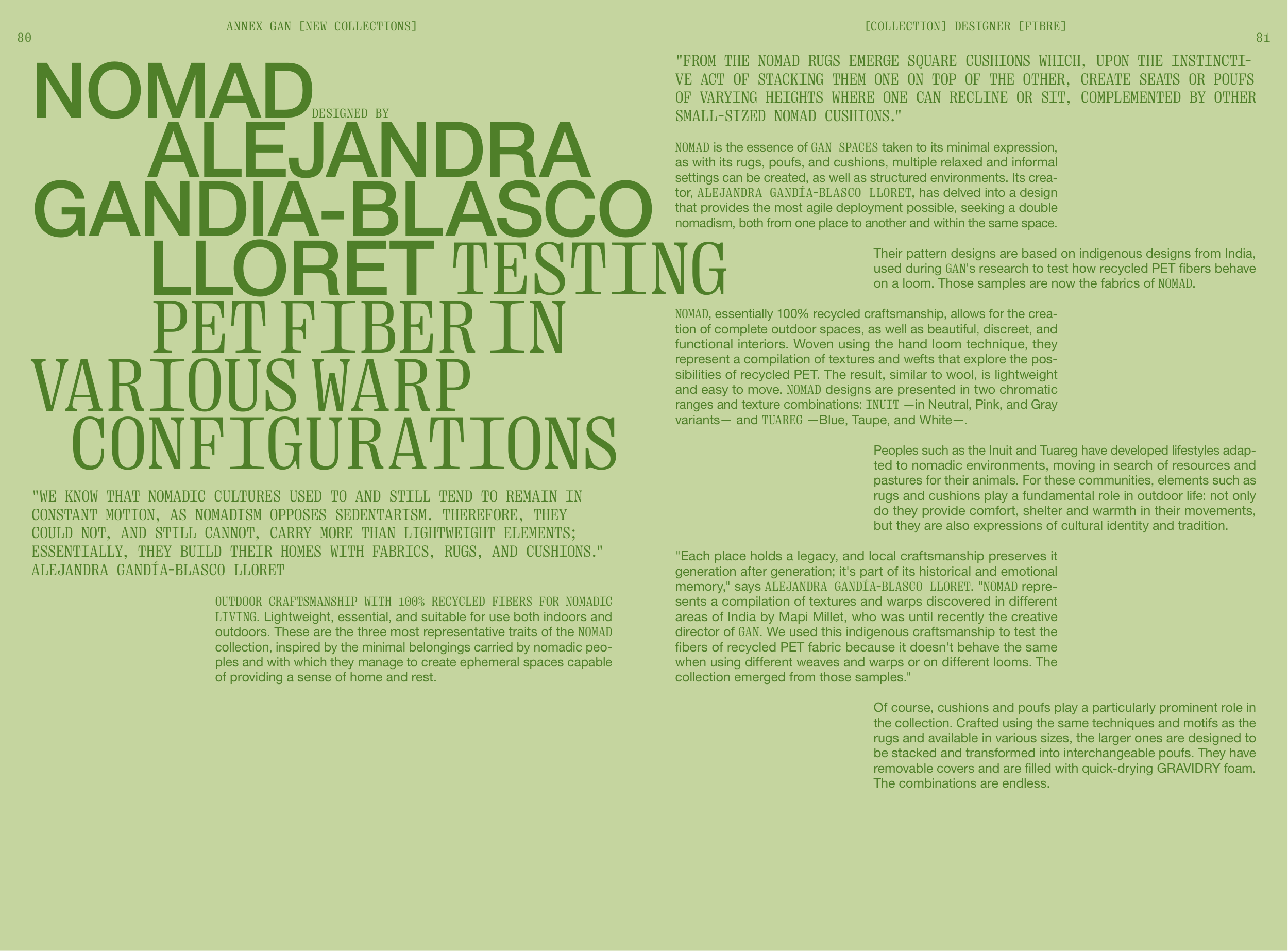NOMADDESIGNED BY
ALEJANDRA
GANDIA-BLASCO
LLORET
NOMAD is the essence of GAN SPACES taken to its minimal expression,
as with its rugs, poufs, and cushions, multiple relaxed and informal
settings can be created, as well as structured environments. Its crea-
tor, ALEJANDRA GANDÍA-BLASCO LLORET, has delved into a design
that provides the most agile deployment possible, seeking a double
nomadism, both from one place to another and within the same space.
NOMAD, essentially 100% recycled craftsmanship, allows for the crea-
tion of complete outdoor spaces, as well as beautiful, discreet, and
functional interiors. Woven using the hand loom technique, they
represent a compilation of textures and wefts that explore the pos-
sibilities of recycled PET. The result, similar to wool, is lightweight
and easy to move. NOMAD designs are presented in two chromatic
ranges and texture combinations: INUIT —in Neutral, Pink, and Gray
variants— and TUAREG —Blue, Taupe, and White—.
"Each place holds a legacy, and local craftsmanship preserves it
generation after generation; it's part of its historical and emotional
memory," says ALEJANDRA GANDÍA-BLASCO LLORET. "NOMAD repre-
sents a compilation of textures and warps discovered in different
areas of India by Mapi Millet, who was until recently the creative
director of GAN. We used this indigenous craftsmanship to test the
fibers of recycled PET fabric because it doesn't behave the same
when using different weaves and warps or on different looms. The
collection emerged from those samples."
Their pattern designs are based on indigenous designs from India,
used during GAN's research to test how recycled PET fibers behave
on a loom. Those samples are now the fabrics of NOMAD.
Peoples such as the Inuit and Tuareg have developed lifestyles adap-
ted to nomadic environments, moving in search of resources and
pastures for their animals. For these communities, elements such as
rugs and cushions play a fundamental role in outdoor life: not only
do they provide comfort, shelter and warmth in their movements,
but they are also expressions of cultural identity and tradition.
Of course, cushions and poufs play a particularly prominent role in
the collection. Crafted using the same techniques and motifs as the
rugs and available in various sizes, the larger ones are designed to
be stacked and transformed into interchangeable poufs. They have
removable covers and are filled with quick-drying GRAVIDRY foam.
The combinations are endless.
"FROM THE NOMAD RUGS EMERGE SQUARE CUSHIONS WHICH, UPON THE INSTINCTI-
VE ACT OF STACKING THEM ONE ON TOP OF THE OTHER, CREATE SEATS OR POUFS
OF VARYING HEIGHTS WHERE ONE CAN RECLINE OR SIT, COMPLEMENTED BY OTHER
SMALL-SIZED NOMAD CUSHIONS."
TESTING
PET FIBER IN
VARIOUS WARP
CONFIGURATIONS
"WE KNOW THAT NOMADIC CULTURES USED TO AND STILL TEND TO REMAIN IN
CONSTANT MOTION, AS NOMADISM OPPOSES SEDENTARISM. THEREFORE, THEY
COULD NOT, AND STILL CANNOT, CARRY MORE THAN LIGHTWEIGHT ELEMENTS;
ESSENTIALLY, THEY BUILD THEIR HOMES WITH FABRICS, RUGS, AND CUSHIONS."
ALEJANDRA GANDÍA-BLASCO LLORET
OUTDOOR CRAFTSMANSHIP WITH 100% RECYCLED FIBERS FOR NOMADIC
LIVING. Lightweight, essential, and suitable for use both indoors and
outdoors. These are the three most representative traits of the NOMAD
collection, inspired by the minimal belongings carried by nomadic peo-
ples and with which they manage to create ephemeral spaces capable
of providing a sense of home and rest.
ANNEX GAN [NEW COLLECTIONS]
[COLLECTION] DESIGNER [FIBRE]
80
81


